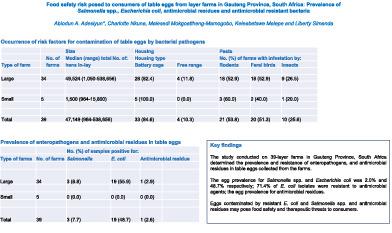当前位置:
X-MOL 学术
›
J. Food Saf.
›
论文详情
Our official English website, www.x-mol.net, welcomes your feedback! (Note: you will need to create a separate account there.)
Food safety risk posed to consumers of table eggs from layer farms in Gauteng Province, South Africa: Prevalence of Salmonella species and Escherichia coli, antimicrobial residues, and antimicrobial resistant bacteria
Journal of Food Safety ( IF 2.4 ) Pub Date : 2020-02-26 , DOI: 10.1111/jfs.12783 Abiodun A. Adesiyun 1 , Charlotte Nkuna 2 , Malesedi Mokgoatlheng‐Mamogobo 2 , Keleabetswe Malepe 3 , Liberty Simanda 4, 5
Journal of Food Safety ( IF 2.4 ) Pub Date : 2020-02-26 , DOI: 10.1111/jfs.12783 Abiodun A. Adesiyun 1 , Charlotte Nkuna 2 , Malesedi Mokgoatlheng‐Mamogobo 2 , Keleabetswe Malepe 3 , Liberty Simanda 4, 5
Affiliation

|
The study conducted on 39‐layer farms in Gauteng Province, South Africa determined the prevalence and resistance of enteropathogens, and antimicrobial residues in table eggs collected from the farms. Eggs were tested for the presence of bacteria using standard methods. The resistance of bacteria to eight antimicrobial agents was determined using the disc diffusion method. Antimicrobial residues were detected in table eggs using the microbial inhibition test, enzyme‐linked immunosorbent assay (ELISA), and high performance liquid chromatography (HPLC). Risk factors for egg contamination by bacteria and antimicrobial residues were determined through a questionnaire survey of farmers. The farm prevalence of Salmonella spp. and Escherichia coli in table eggs was 7.7 and 48.7%, respectively. Nineteen (48.7%) and 2 (5.1%) of eggshells and egg contents, respectively, were positive for E. coli but only eggshells yielded Salmonella species, 2.0% (4 of 196). Overall, 71.4% of 49 E. coli isolates exhibited resistance to one or more antimicrobial agents. The farm prevalence and egg content prevalence of antimicrobial residues was 2.6 and 0.5%, respectively, with the detection of sulfonamide (79 ppb) and oxytetracycline (106 ppb). The prevalence of resistant E. coli and Salmonella spp. and the occurrence of antimicrobial residues in egg content may pose food safety and therapeutic threats to consumers.
中文翻译:

南非豪登省产蛋场的食用鸡蛋消费者面临的食品安全风险:沙门氏菌和大肠杆菌的流行,抗菌素残留物和抗菌素耐药菌
在南非豪登省39层农场进行的研究确定了肠道病原菌的患病率和抵抗力以及从这些农场收集的食用鸡蛋中的抗菌素残留。使用标准方法测试鸡蛋中细菌的存在。使用圆盘扩散法确定细菌对八种抗菌剂的耐药性。使用微生物抑制试验,酶联免疫吸附测定(ELISA)和高效液相色谱(HPLC)在食用鸡蛋中检测出抗生素残留。通过对农民的问卷调查确定了鸡蛋被细菌和抗菌素残留污染的危险因素。沙门氏菌属的农场流行。和大肠杆菌食用鸡蛋的比例分别为7.7和48.7%。E的蛋壳和蛋含量分别为19(48.7%)和2(5.1%)为阳性。大肠杆菌但只有蛋壳可产生沙门氏菌,占2.0%(196个中的4个)。总体而言,占49 E的71.4%。大肠杆菌分离物表现出对一种或多种抗菌剂的抗性。检测出磺胺(79 ppb)和土霉素(106 ppb)后,抗菌素残留的农场患病率和鸡蛋含量患病率分别为2.6%和0.5%。耐药E的流行。大肠杆菌和沙门氏菌spp。鸡蛋中含有抗菌残留物,可能对消费者构成食品安全和治疗威胁。
更新日期:2020-02-26
中文翻译:

南非豪登省产蛋场的食用鸡蛋消费者面临的食品安全风险:沙门氏菌和大肠杆菌的流行,抗菌素残留物和抗菌素耐药菌
在南非豪登省39层农场进行的研究确定了肠道病原菌的患病率和抵抗力以及从这些农场收集的食用鸡蛋中的抗菌素残留。使用标准方法测试鸡蛋中细菌的存在。使用圆盘扩散法确定细菌对八种抗菌剂的耐药性。使用微生物抑制试验,酶联免疫吸附测定(ELISA)和高效液相色谱(HPLC)在食用鸡蛋中检测出抗生素残留。通过对农民的问卷调查确定了鸡蛋被细菌和抗菌素残留污染的危险因素。沙门氏菌属的农场流行。和大肠杆菌食用鸡蛋的比例分别为7.7和48.7%。E的蛋壳和蛋含量分别为19(48.7%)和2(5.1%)为阳性。大肠杆菌但只有蛋壳可产生沙门氏菌,占2.0%(196个中的4个)。总体而言,占49 E的71.4%。大肠杆菌分离物表现出对一种或多种抗菌剂的抗性。检测出磺胺(79 ppb)和土霉素(106 ppb)后,抗菌素残留的农场患病率和鸡蛋含量患病率分别为2.6%和0.5%。耐药E的流行。大肠杆菌和沙门氏菌spp。鸡蛋中含有抗菌残留物,可能对消费者构成食品安全和治疗威胁。



























 京公网安备 11010802027423号
京公网安备 11010802027423号